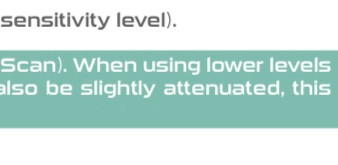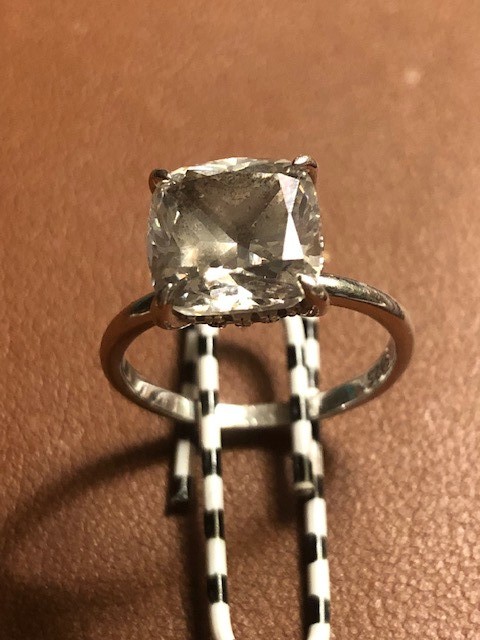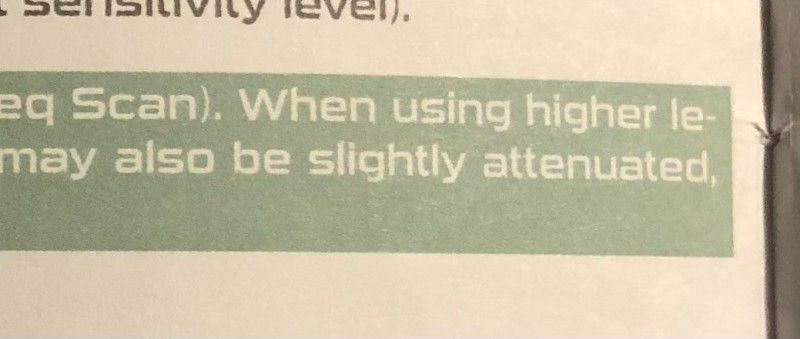-
Posts
587 -
Joined
-
Last visited
Content Type
Forums
Detector Prospector Home
Detector Database
Downloads
Posts posted by ColonelDan
-
-
1 hour ago, midalake said:
So have we figured this out? Is 9 the high of the scale or low of the scale?
One would assume that 9 was high and 1 was low. ? However, thru my testing on Sunday, I'm going to establish my salt sensitivity start point by determining whatever level is the most stable that can reliably detect that small gold ring....regardless of the number or what the manual says. I'm going after the "sweet spot." If that's 1 OK, if it's some other number, that's OK too. My only interest is optimal performance.
-
 2
2
-
-
In a separate thread, I addressed the question asking why one shouldn't just set the Salt Sens at 1 Based on the manual position on page 18 which says that the higher the Salt Sens setting is, TIDs less than 30 would be attenuated.
The hard copy manual clearly uses "higher" as shown.
Later I saw where the on line version states that the "lower" the Setting, the TIDs less than 30 would be attenuated.
On Line Manual

It seems that XP has a discrepancy here. In any case, I intend to test this on Sunday to try and determine what effect low salt sens settings have on a thin 10k ring.
I'll post my observations shortly thereafter.
Just be aware that there is a discrepancy in the manuals.
-
 4
4
-
-
I'm going to give the theory a true test on Sunday by using this thin 10k gold ring in the wet salt sand of New Smyrna Beach. I'll post my observations soon thereafter.
-
 5
5
-
-
midalake, I use tracking on our beaches and it works fine. The mineralization on our beaches is very uniform so tracking works well.
-
 2
2
-
-
Sandheron, yes, I saw that but the manual I have references higher levels of salt sensitivity settings. I honestly haven’t experienced attenuatiion in my testing. Using my modified beach sensitive program, the lower TID targets are detected easily. I’m sure I’m missing something here. No old cavalry guy is more clever than the XP design engineers! ?
-
 1
1
-
-
Coming from years of a Minelab back ground, admittedly, I am still learning the nuances of the Deus II. Given that, I’ve been experimenting with my Salt Sensitive setting. I’ve been lowering this setting incrementally and now have tried it all the way down to 1 and see no downside. In fact, I see a more stable Deus than ever before. I’ve tested this setting for depth and sensitivity and have not seen any degradation of overall performance in a salty environment.
Thinking about this, here’s my logic. With a setting at 9, the Deus is the most sensitive to salt. As we continue to lower that setting, the sensitivity to salt is reduced incrementally. At some point the Deus II becomes stable in a wet salt environment. Given that the lower the setting, the less sensitive it is to salt, why not just lower it down to the lowest setting of 1 so that it is the least sensitive possible? After all, we aren’t trying to detect salt so why not eliminate the effects of that salt as much as possible?
Where am I off base here? What am I missing? What’s the downside to a Salt Sensitivity setting at 1?
-
Chase, I am very happy with the 925 part....no question. ?
-
 1
1
-
-
Yes it was an eye popper…. Peaking out of the wet sand at me ?
-
 2
2
-
-
- Popular Post
- Popular Post
This one had my heart rate going for about 2 seconds until I saw the 925 on the inside. I knew immediately that no 925 ring would have an authentic diamond of that size. Turned out to be zirconium. Mary said that although it had a nice sparkle, I should keep it with my other junk rings! ?

-
 12
12
-
 2
2
-
 1
1
-
 2
2
-
Outstanding haul. Yes, you will be able to track down the Texas A&M owner easily and they will be very grateful to get that one back!
Good job...
-
 1
1
-
-
I'm a Florida beach hunter and I've used Minelabs for years...Etrac, Safari, Excal, CTX, Equinox and Vanquish. I now use the Deus II exclusively for many of the same reasons cited above. The overall performance on the beach is better than the Minelabs in my opinion....sensitivity at depth, reactivity/separation, customizable, weight, compact, rugged, stable in a saltwater environment and this one really is waterproof! Minelab's current offering of coil choices however bests XP to date...no question.
Granted, the Minelabs are excellent machines no doubt, but XP has fielded state of the art with the Deus II...in my opinion and it's just my opinion based on years of using and now comparing Minelabs to the Deus II.
I also owned a Deus I years ago but sold it because it just couldn't compete with the Minelabs on saltwater beaches. It was a selectable frequency machine that just wasn't up to the challenges presented by any saltwater environment. Now that XP has fielded the Deus II, that shortcoming has been overcome....and in a superior way.
But as I always say, that's just the view from my foxhole...your view may very well differ.
-
 2
2
-
-
Absolutely wonderful!
-
 1
1
-
-
Yes, the iron tone starts at the disc level and below and the iron tone level can be adjusted.
-
CPT, is right. Sandy beaches and saltwater environments are the harshest conditions on equipment. Ergo, I take great pains in cleaning all my things after each hunt. Even if you don’t submerge your coil, the salt spray still gets on everything so take care. Also, I don’t overly tighten the coil ear bolt and I put a light coating of Never Seize on the bolt assembly…a very light coat and clean that and reapply periodically.
Just the life of a beach hunter! ?-
 1
1
-
-
Good job!
-
 1
1
-
-
Brad, Regarding the notch function, as I stated in the OP, I never notch any range of numbers as the variation of gold metallurgical composition spans a wide range of TID numbers in the mid conductivity scale. You could easily notch out a nice gold ring when trying to eliminate some forms of junk.
-
 6
6
-
-
- Popular Post
- Popular Post
For many years, I detected our Florida beaches with various Minelab detectors set up in a custom 3 tone setting based on low, mid and high conductive targets. This combination served me very well over those years in the Minelab world so when I bought the Deus 2, I programmed Beach and Beach Sensitive the same way--3 tones. However, in my on-going effort of transitioning to the XP world, I quickly learned that the Deus 2, being the sophisticated detector it is, was apt to be more chatty on a saltwater beach if not set up properly beyond just my 3 tone solution.
After experimentation with sensitivity, salt sensitivity, reactivity, silencer, bottle cap rejection and discrimination, (more options than I was used to with the Minelabs,) I was able to stabilize it to what I thought was at least a somewhat satisfactory level...again in 3 tones.
But thanks to some educational exchanges, I was introduced to the Deus 2 Square Pitch option. Coupled with the right levels of discrimination and silencer settings, this set up is essentially a nuanced 2 tone program. Since I always dug both the mid and high level tones of my 3 tone set up anyway, this wasn’t all that much different in terms of dig/no dig decisions except now there was the same tone frequency for all non-ferrous targets.
Although still in the early stages of learning the finer points of this Deus 2, I’m impressed with the square pitch option. These settings hit good targets hard and ID’d bottle caps and ferrous targets much better than my original 3 tone option. Additionally, it proved to be far less chatty on my Florida saltwater beaches than the 3 tone set up.
Bottom Line; I’m a square pitch convert. If you’re a Deus 2 saltwater beach hunter also, I recommend you at least give this set up a try.
My preferred baseline settings for saltwater beaches in Beach and Beach Sensitive are now:
Discrimination 6.5 and Silencer 0
Square Pitch
The remainder is a combination of situational needs determined through on-site experimentation, testing and actual use and finally, personal preference.
Adjusted as conditions require:
Sensitivity: 95
Salt Sensitivity: 7
Reactivity 0-1.5
Personal Preference:
Notch: Off (Gold falls anywhere along the mid level spectrum so I never notch out anything.)
Bottle Caps: 3
Iron Volume: 3
Audio Response: 5 or 6
Audio Out: 9
My next step is finding the best combination of settings for detecting 19th century artifacts in fresh water. I’ll start my search with square pitch in a custom Park program—but only actual use in a fresh water environment will tell the tale.
Just the view from my converted beach front foxhole. Your analysis and conclusions may differ.
-
 12
12
-
On any evaluation I’ve ever read of a given detector or a head to head comparison, the discussion invariably reverts to the subject of raw detectable depth—it seems the “holy grail” of evaluating a detectors worth can be answered with these two questions. “How deep is detector A? Is it deeper than detector B?”
Many years ago, I convinced myself that sensitivity and reactivity were far more important to me than raw depth. I zeroed in on sensitivity and reactivity as it relates to separation and identification at various depths and under various soil/sand conditions. Given that, all the depth testing I ever did focused on sensitivity at a given depth rather than raw detectable depth under a variety of conditions we find in the field. Why?
Detectable depth is affected/impacted/determined by many more external factors than just the sophistication of the detector’s internal technology alone. Such factors as soil/sand composition, moisture and mineralization levels, the target’s metallurgical composition, orientation in the soil/sand and level of degradation/condition and even the overall amount of EMI in the area.
Granted, sensitivity can also be affected by these same factors and hamper any detectors ability to properly and consistently detect and identify the target. However, I’m more impressed by a detector that can accurately identify a target or separate it from junk at a given depth than one which can merely “see” the target at that same or similar depth but can’t identify or separate it from the junk.
While I’m not summarily discounting detectable depth as a desirable capability in a detector, I value its degree of sensitivity more so which enables it to accurately identify and separate the target from that ever present trash. However, as I always say, that’s just me and the view from my foxhole. Your preferences may very well differ.
-
 8
8
-
-
This might work for you.
https://www.colonialmetaldetectors.com/xp-deus-remote-case.html
-
 2
2
-
-
This is exactly why I never notch out anything. Never have; never will.
Just the view from my foxhole….
-
 1
1
-
-
1 hour ago, Chase Goldman said:
Congrats! I just got junk bling on my recent beach trip, but it was fun and I learned a lot about the D2 and the inadequacies in my scooping technique in rough surf.

Pinpointing and scooping in rough surf is a real challenge for anybody...including experienced beach hunters like me! At 74 however, I don't do rough surf anymore. Tame oceans are my friend these days!!! ?
-
 5
5
-
 1
1
-
-
The higher the discrimination setting the greater number of targets will register as ferrous. If for example you set the discrim at 7, targets'TDI that range from 7 or below will be reported as "iron."
-
 1
1
-
-
5 minutes ago, Calmark said:
Yesterday while park hunting, two ladies approached and asked questions about metal detecting. One of them placed a small and thin white gold band with what looked like a small diamond in the center on the ground and asked if the Deus 2 could hear it. Among some flashes of 9-10 ID#, the ring rand up primarily as a 15!
I have known white gold generally will give a low ID# on most detectors, but I didn't expect a number THAT low. I've been missing small white gold like this for sure since I dig few targets under a 40, though I do dig foils down to 32 if I'm in the mood.
So, its looking like if we want white gold and chains/bracelets, its going to be necessary to dig numbers into the teens with the Deus 2!

I've known some gold to ring up low like that too so I've set my iron tone break at 10. Will I dig more trash that way? Yes, but our beaches don't contain much true iron...aluminum is the culprit here. Thanks for the report!
-
 1
1
-
-
Great review! ?
-
 1
1
-




Salt Sens Setting: High Or Low--discrepency
in XP Deus II Forum
Posted
Chase, that setting (used as a start point) is what I intend to determine on Sunday. ?